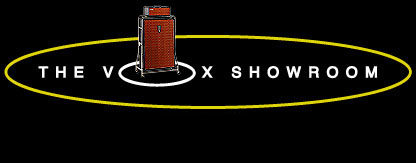 The Vox AC-30 Top Boost and AC-30 Top Boost Reverb - 1970 - 1973
Birch-Stolec Ltd Era
The Vox AC-30 Top Boost and AC-30 Top Boost Reverb - 1970 - 1973
Birch-Stolec Ltd Era

|
|
2_Footer
|
© 1996 - 2024 The Vox Showroom, all rights reserved. No use on online auctions, eBay or Reverb.
|
 |
After Tom Jennings was fired from JMI in 1967, the glory days |
of the "British Invasion" era ended for Vox. Vox would now suffer an uncertain future and a series of rapid ownership changes.
The downward spiral for Vox started with the bankruptcy of the Royston Group in 1967. This led to the formation and subsequent failure of Vox Sound Equipment Limited in 1968 and 1969. The investment firm Corinthian Securities purchased Vox in 1969 and sold it to Birch-Stolec Ltd and the Schroder Bank in 1970. Birch-Stolec Ltd.
Founded by John Birch and John Stole and financed by the Schroder Bank, Birch-Stolec Ltd was a manufacturing and distribution firm that marketed Eveready Batteries, John Birch sunglasses and electronic components in the UK. After Birch-Stolec Ltd. purchased Vox in 1970, they moved the manufacturing facilities from Erith, Kent to one of their existing facilities in Hastings, Essex.
| Lemark Transformers, another company owned by Birch-Stolec, had been selling transformers to Vox for several years. You can see a Lemark power transformer installed into a 1969 Vox AC-30 in a photo at right. |
 |
Birch-Stolec Era Vox Products
The management at Birch-Stolec Ltd. continued to build the series of solid state Vox amplifiers (Supreme, Defiant, Foundation Bass and Super Foundation) whose modular, printed circuit construction was designed for cost efficiency and ease of manufacture. Birch-Stolec also desired to produce the iconic AC-30, whose hand wired tube design was still commercially viable but expensive and time consuming to manufacture. Birch-Stolec decided to reduce AC-30 production costs by replacing the original hand wired design with two printed circuit boards. Birch-Stolec did not understand the problems this redesign would create.
|
Printed Circuit Board Construction
Printed circuit board construction is best suited for transistorized circuits where both heat and current draw are minimized. Designing a tube amp on a printed circuit board presents a number of engineering challenges.
|
Problems can occur when too much current is drawn through a circuit trace. A circuit trace can be vaporized by excessive current draw, in turn causing a failure. Something as common as a shorted tube can lead to this problem. Such failures could easily occur on the Birch-Stolec AC-30.
Heat related failures also haunted the Birch-Stolec AC-30. All of the tube sockets for the Birch-Stolec AC-30 were mounted directly to the printed circuit board. This allowed the heat from the tubes to transfer directly to the PCB, often causing the circuit board to warp.
The fragile nature of the printed circuit boards in the Birch-Stolec era AC-30 gave the amp a bad reputation for dependability. In later years, innovations in design, such as mounting the tube sockets to the chassis rather than to the PCB, allowed circuit boards to be successfully incorporated into the AC-30.
Soon after Dallas Musical Industries purchased Vox from Birch-Stolec in 1973, Dallas replaced the printed circuit AC-30 with a hand wired model.
|
|
|
Tube Complement
The Birch-Stolec AC-30 Top Boost shown on this web page included five ECC83, one ECC82, four EL-84 tubes and a GZ-34 tube rectifier. A second version of the Birch-Stolec AC-30 eliminated the GZ-34 tube in favor of a diode rectified power supply. You can view chassis photos showing the tube layout on the Birch-Stolec AC-30 "Under the Hood" web page.
Speakers
Two silver Celestion G12 Alnico speakers were installed in the Birch-Stolec AC-30. The magnet covers have been removed from the backs of the Almico speakers on the AC-30 amplifier pictured near the top of this page.
|


|
Cabinet
The earliest examples of the Birch-Stolec AC-30 used the same baltic birch cabinet found on Vox Sound Equipment Limited (VSEL) AC-30 amps produced from 1968 through 1970. These cabinets included black Vox grill, six slender air vents and a American style horizontal Vox logo (see photo at left) In later production, ventilation was improved by the installation of five large air vents on the top of the cabinet (see photo at lower left).
Dallas Musical Industries acquired an inventory of printed circuit AC-30 amps with large air vents as part of the purchase of Vox from Birch-Stolec. These Stolec era AC-30 amps were liquidated in a 1974 Vox catalog printed by Dallas.
Reverb
Birch-Stolec offered the first version of the AC-30 combo that included reverb as an option. The addition of reverb to the AC-30 became a necessity due to the increased UK popularity of the Fender Twin Reverb. The control panel mounted rotary voltage selector was eliminated to make room for the reverb control.
|
|
|
Photo Credits
Chassis photos courtesy Champ Electronics, Nottingham England, used with permission of the copyright holder.
|
 North Coast Music offers many factory licensed cosmetic replacement
North Coast Music offers many factory licensed cosmetic replacement
and repair for the Rose Morris Vox AC30. Some are shown below.
|
3_Footer

Photos and editorial content courtesy Gary Hahlbeck, North Coast Music
Any and all material presented herein is protected by Copyright.
© 1998 - 2024 The Vox Showroom and North Coast Music, all rights reserved
The images and editorial content in this web site may not be copied or reproduced
in online auction sites such as eBay, Reverb and Craig's List. Sellers may provide a link
to the Vox Showroom web site if they wish to refer to this copyrighted material.
|
URL: http://www.voxshowroom.com/uk/amp/birch-stolec_ac30.html
|

